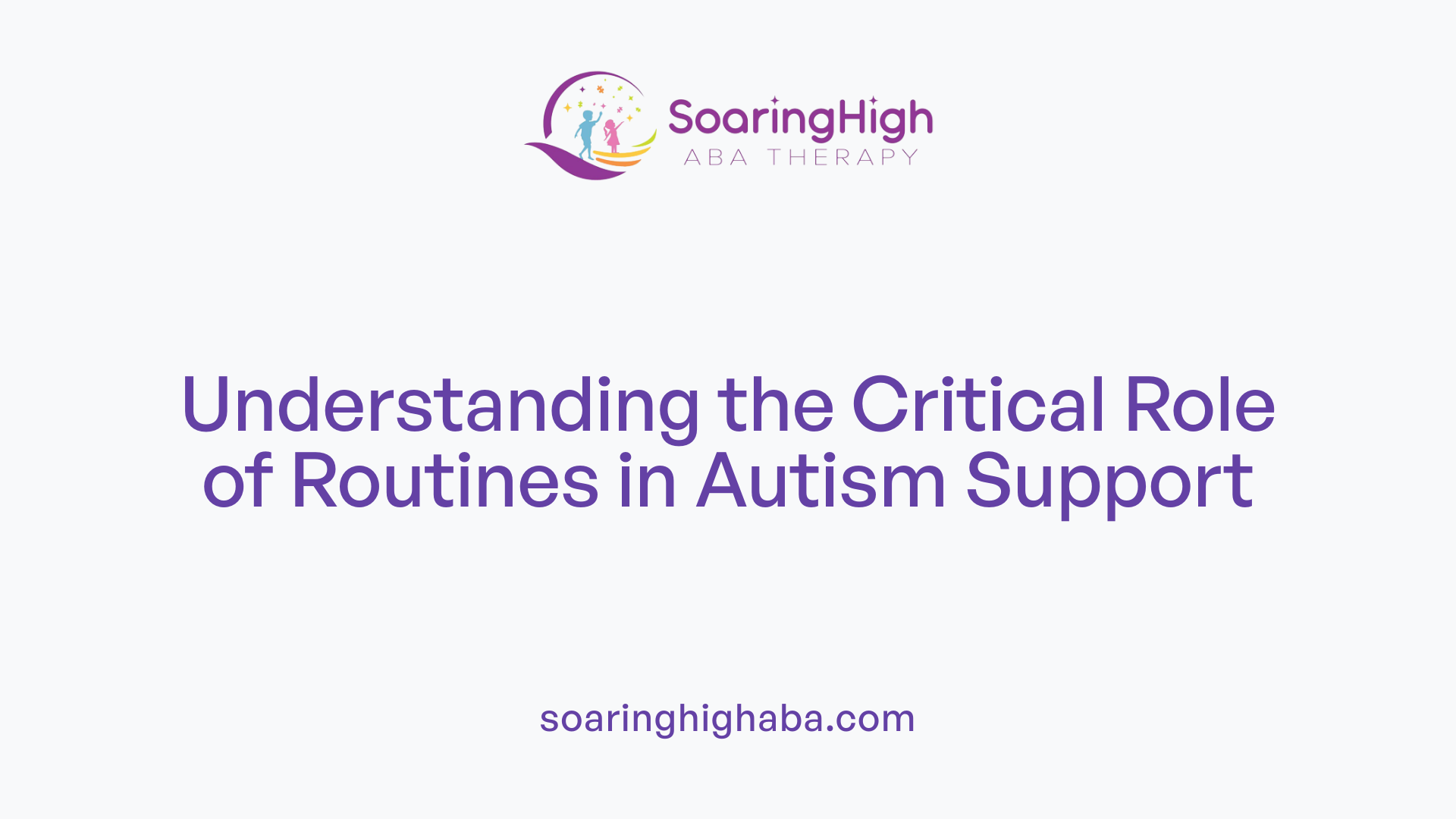Understanding the vital role of structured routines and ABA therapy
Autism spectrum disorder (ASD) presents unique challenges that can often be managed more effectively through carefully designed routines supported by Applied Behavior Analysis (ABA) therapy. This article explores how incorporating ABA principles into daily routines helps children develop essential skills, manage transitions, and foster independence, ultimately improving their quality of life.
The significance of routines in supporting children with autism

Why are routines important for children with autism?
Implementing structured daily routines plays an essential role in helping children with autism develop key skills and feel secure. When children follow a predictable schedule, it reduces feelings of confusion and anxiety, making transitions smoother and daily participation more manageable.
Visual schedules, timers, and clear cues contribute significantly by providing visual and auditory support that enhances understanding and independence. A consistent routine not only offers emotional comfort but also underscores expectations, encouraging children to engage actively and confidently with their environment.
How routines contribute to skill development and confidence
Structured routines serve as a natural platform for practicing important skills. For example, mealtimes can be used to improve communication and decision-making, while bedtime routines help establish calming habits that promote better sleep.
Incorporating ABA strategies—such as task analysis, positive reinforcement, and visual tools—within daily routines fosters skill building. Children learn to complete activities independently, manage transitions, and develop social interaction skills.
These routines reinforce positive behaviors through rewards and prompts, gradually increasing a child's independence and self-confidence. Engaging caregivers and family members in routine practice enhances consistency and provides opportunities for meaningful interaction.
Overall, a well-organized daily schedule not only supports the learning and development of children with autism but also fosters a sense of security, empowering them to navigate their world with greater ease.
| Aspect | Strategy | Benefit |
|---|---|---|
| Routine Structure | Visual schedules, timers | Reduces anxiety, promotes independence |
| Behavior Reinforcement | Positive reinforcement | Encourages desired behaviors |
| Skill Practice | Task analysis, modeling | Builds daily living skills |
| Family Involvement | Caregiver participation | Enhances consistency and learning |
| Sensory Management | Sensory-friendly spaces | Supports emotional regulation |
Creating and maintaining consistent routines, tailored to each child's needs, significantly enhances the effectiveness of ABA therapy, leading to improved behavior, skill generalization, and confidence building in children with autism.
Core components of ABA strategies in routine management

What are the main ABA strategies used in managing daily routines?
ABA therapy incorporates several effective techniques to help children with autism follow routines and develop important skills. These strategies include task analysis, positive reinforcement, and visual schedules.
Task analysis involves breaking down daily activities into smaller, manageable steps. For instance, brushing teeth can be divided into steps like picking up the toothbrush, applying toothpaste, and brushing for a set time. This step-by-step approach makes tasks less overwhelming.
Positive reinforcement rewards children for completing steps or following routines correctly. Rewards can be praise, extra playtime, or preferred items, encouraging children to repeat desirable behaviors.
Visual schedules are tools like pictures or charts displaying daily activities in order. These visuals help children understand what to expect and support independence.
How does behavior analysis improve routine effectiveness?
Behavior analysis is at the core of ABA therapy. It helps understand how children respond to different stimuli and guides the development of tailored strategies. By observing behaviors, therapists identify what motivates each child and what triggers challenging behaviors.
This understanding allows for adjustments in routines and interventions that maximize success. For example, if a child gets overwhelmed during transitions, visual cues and countdown timers can be used to prepare them.
What behavioral techniques are used to support learning in routines?
Therapists commonly utilize prompting and shaping behaviors to promote independence. Prompting uses cues, like gestures or words, to guide a child through a task. Over time, prompts are gradually faded as the child gains independence.
Shaping involves reinforcing small steps toward a desired behavior, helping children learn complex skills gradually. These methods are essential for teaching routine-related tasks and ensuring skills are generalized across settings.
Overall, combining these strategies creates a structured and predictable environment. This approach supports children in mastering daily routines, reducing anxiety, and building confidence in their independence.
| Technique | Purpose | Example | Additional Details |
|---|---|---|---|
| Task analysis | Breaks tasks into manageable steps | Tooth brushing steps | Supports skill building in small increments |
| Positive reinforcement | Rewards desired behaviors to increase frequency | Praising a child for completing a step | Reinforces participation and success |
| Visual schedules | Enhances predictability and independence | Pictures of daily activities | Guides children through routines |
| Prompting | Guides behavior, then fades over time | Gestures or cues to start a task | Fosters independence |
| Shaping | Reinforces successive approximations of skills | Gradually teaching new behaviors | Encourages gradual skill mastery |
Implementing these techniques within daily routines helps children with autism develop essential skills, gain independence, and participate more fully in everyday life.
Practical implementation of ABA at home and in daily activities
Establishing visual schedules, incorporating timers, using social stories
Creating predictable routines is essential for children with autism. Visual schedules using pictures or symbols help children understand what comes next, providing a sense of security. Incorporating timers can help manage transitions smoothly and reduce anxiety. For example, a timer set for activities like playtime or cleanup cues children to finish tasks, making transitions clear and less stressful.
Social stories are another effective tool. These are short, illustrated stories that teach children about specific routines, behaviors, or social situations. Reading social stories before activities like visiting a new place or going to bed helps children prepare emotionally and cognitively.
Practicing communication, transitions, and self-care routines
Embedding communication opportunities into daily routines encourages expressive language and decision-making. During mealtime, children can practice asking for items or choosing what they want to eat, reinforcing communication skills.
Transitions between activities—such as moving from playtime to a bath—should be planned and reinforced with visual cues like pictures or signals. Consistent use of these cues helps children move smoothly from one activity to the next.
Self-care routines, such as brushing teeth or dressing, benefit from clear, step-by-step visual guides. Repeating these routines with support and positive reinforcement builds independence and confidence.
Involving caregivers in reinforcing skills
Family members and caregivers play a vital role in reinforcing skills learned through ABA. Consistent praise and rewards strengthen positive behaviors and help children understand expectations.
Caregivers should practice prompting and modeling desired behaviors, gradually fading prompts as the child becomes more independent. Keeping data on routines and skill progress allows for tailored adjustments and ongoing motivation.
By actively participating in daily routines with structured strategies like visual schedules, timers, and social stories, caregivers can greatly enhance the effectiveness of ABA therapy, fostering independence and reducing stress for children with autism.
The role of daily routines in skill acquisition and behavioral outcomes
Does ABA therapy help teach life skills?
Yes, ABA therapy is highly effective in teaching essential life skills to children with autism. It focuses on improving communication, social interaction, self-care, and problem-solving abilities using a variety of evidence-based methods. Techniques such as visual supports, role-playing, social stories, and reinforcement are frequently employed to reinforce positive behaviors and skills.
Establishing routines is a core part of ABA therapy, as consistent, structured activities provide opportunities for children to practice and internalize new skills. These routines, whether at home or in therapy sessions, help children develop independence and confidence in managing daily activities. Early intervention with ABA maximizes developmental gains by utilizing the brain’s plasticity, supporting children in acquiring skills that generalize across settings.
By systematically breaking down skills into manageable parts, ABA helps children learn to dress, eat, brush teeth, and participate in other daily tasks more effectively. Moreover, routines reduce anxiety and create predictable environments that foster learning. When behavioral challenges are addressed through tailored interventions, children often become more adaptable and autonomous.
In summary, ABA therapy equips children with autism with the skills necessary for greater independence, aiding them in navigating the complexities of daily living and improving overall quality of life.
How do routines enhance skill development?
Daily routines serve as the foundation for consistent learning and behavioral improvement. They establish predictability, which is calming and encouraging for children with autism. Routines also provide multiple opportunities to reinforce skills through ongoing practice, making behaviors more automatic.
For example, routines around mealtime can help children practice communication and decision-making. Bedtime routines support better sleep, which influences focus and emotional regulation. Activities like dressing and hygiene routines foster independence and self-care skills.
Using visual tools like schedules, timers, and picture cues within routines further enhances understanding and independence. Consistent reinforcement during these activities encourages children to follow steps accurately and develop desired behaviors.
When routines are aligned with therapy goals, children learn to transition smoothly between activities, reducing frustration. Caregivers and family involvement reinforce these skills in natural environments, promoting generalization.
To maximize effectiveness, routines should be adjusted based on individual responses, ensuring they remain engaging and supportive of ongoing progress.
How does routine building support generalization of skills?
Skill generalization—the ability to apply learned skills across different settings—is essential for meaningful progress. Well-structured routines facilitate this by providing consistent contexts for practicing behaviors.
For instance, a child who learns to greet peers during a structured play routine at home can transfer this skill to school. Using the same visual cues and reinforcement strategies across environments helps children understand that these behaviors are expected everywhere.
Natural Environment Teaching (NET) integrates real-world activities into routines, creating meaningful learning opportunities. Routine-based practice, combined with data collection and ongoing adjustments, helps ensure skills are maintained and generalized.
Visual supports, timers, and social stories used during routines make transitions smoother and promote independent engagement across different settings.
By embedding ABA strategies into daily routines, children are more likely to develop flexible, adaptable behaviors that serve them well beyond therapy sessions.
How are daily routines constructed to support skill development?
Creating effective routines involves identifying essential activities like waking up, meals, hygiene, therapy sessions, play, and bedtime. Setting regular times for these activities provides structure.
Incorporating visual schedules, pictures, and clear cues helps children anticipate what comes next and participate more independently. Providing choices within routines fosters decision-making skills.
Including breaks and motivators ensures children stay engaged and motivated. Caregivers should regularly observe and adjust routines based on the child’s responses.
A sample routine may include morning tasks like brushing teeth and getting dressed, followed by therapy, outdoor play, meals, and family time, ending with a consistent bedtime.
Using positive reinforcement during each activity encourages children to follow routines and develop new skills. Consistency, combined with flexibility to adapt as needed, supports ongoing progress.
Overall, structured routines create a predictable environment that promotes learning, reduces anxiety, and fosters independence, forming a vital component of successful ABA therapy outcomes.
Typical daily routines integrated with ABA principles
 For children with autism, establishing a predictable daily routine is essential and can be optimized through ABA strategies to promote independence and reduce anxiety.
For children with autism, establishing a predictable daily routine is essential and can be optimized through ABA strategies to promote independence and reduce anxiety.
A typical day may start with a structured morning routine. This can include activities like using the bathroom, brushing teeth, and getting dressed. Visual schedules, which use pictures or images to represent each task, support understanding and independence. Timers can be employed to help children know when activities are about to change, making transitions smoother.
During the school or learning hours, routines often involve attending classes, participating in educational activities, and taking scheduled breaks for snacks or lunch. Visual supports, such as schedules or social stories, clarify what to expect and reinforce task completion.
Afternoon routines might include speech or occupational therapy sessions, playtime, and completing homework or other learning activities. These are reinforced with visual aids and consistent timing, helping children generalize skills across different settings.
Evening routines typically cover bath time, brushing teeth, and getting ready for bed. Again, visual cues guide children through each step, fostering independence. Bedtime routines also often incorporate calming activities or stories, with visual supports used to signal winding down.
Incorporating social skills and communication practice into daily routines enhances learning. For example, mealtime can be an opportunity to practice requesting, turn-taking, and using communication devices or gestures. Playtime helps build confidence and social interaction skills through modeling and reinforcement.
Outings or errands serve as real-world situations to apply daily living skills. Preparation and positive reinforcement help children generalize learned behaviors outside the home.
Using visual schedules and timers throughout the day creates structure, supports understanding of transitions, and encourages children to engage more independently with their routines. These tools also help caregivers monitor progress and tailor routines as needed.
Overall, integrating ABA principles into daily routines fosters skill development, promotes consistency, and helps children with autism feel secure and supported in their everyday lives.
Monitoring progress and customizing routines for individual needs

How is data collection and collaboration with therapists important?
Consistent data collection is crucial in ABA therapy as it helps track a child's progress over time. Caregivers and therapists work together by recording observations during daily routines and therapy sessions. These records include how well the child follows routines, responds to prompts, and uses new skills. Such detailed information enables therapists to evaluate the effectiveness of strategies and make informed decisions about necessary adjustments.
How do routines get adjusted based on the child's response?
Children with autism are unique, and their responses to routines can vary. Based on data and ongoing observations, routines are personalized to meet their changing needs. For example, if a child shows signs of distress during transitions, routines might be modified to include additional visual supports or sensory breaks. Flexibility is key, allowing routines to evolve as children develop new skills or encounter challenges.
What about setting realistic expectations and celebrating milestones?
Setting achievable goals helps maintain motivation for children and their families. Break larger objectives into smaller, attainable milestones like completing a morning routine or independently dressing. Celebrating these wins boosts confidence and encourages continued effort. Recognizing even small progress is vital, as it reinforces positive behaviors and keeps everyone motivated to pursue further development.
| Aspect | Strategy | Benefits |
|---|---|---|
| Data Collection | Keep detailed logs | Monitors progress and guides adjustments |
| Routine Adjustment | Personalize routines | Meets individual needs and reduces frustration |
| Celebrating Milestones | Acknowledge small successes | Builds confidence and motivation |
Overall, ongoing monitoring and customization ensure that routines remain effective and supportive of each child's growth, making ABA therapy a dynamic and responsive process.
The benefits of consistent routines supported by ABA for long-term development

How Do Consistent Routines Promote Independence and Social Skills?
Establishing predictable daily routines is fundamental for children with autism participating in ABA therapy. These routines provide a sense of security, helping children feel calm and confident as they navigate their day.
ABA therapy employs strategies like task analysis and positive reinforcement, which are naturally integrated into routines such as meal times, dressing, and bedtime. This consistent structure encourages children to perform tasks independently over time.
By regularly practicing routines, children learn social skills such as turn-taking during play and communication during activities like mealtime. These skills are reinforced through visual schedules and prompts, which make learning engaging and achievable.
How Does Routine Support Reduce Anxiety and Challenging Behaviors?
Children with autism often face sensory sensitivities and difficulty with transitions. Structured routines act as a calming framework, reducing confusion and uncertainty.
Using visual supports like pictures, timers, and visual schedules helps children anticipate upcoming activities, easing transitions between tasks. Consistency in daily schedules diminishes anxiety, which in turn decreases problem behaviors.
Additionally, ABA strategies such as gradual desensitization and sensory diets help children manage sensory sensitivities within routines, promoting calmer responses.
How Does Routine Enhance Learning and Skill Generalization?
Daily routines create meaningful opportunities for practicing and reinforcing skills learned in ABA therapy. For example, a daily walk introduces real-world scenarios for applying social and communication skills.
Incorporating fun activities and positive reinforcement during routines encourages children to stay engaged and motivated. Using visual tools, like communication boards, supports both understanding and expression.
Routine consistency across home and therapy environments helps children transfer and generalize skills, leading to better long-term developmental outcomes.
| Benefit | Description | Supporting Strategies |
|---|---|---|
| Increased independence | Children perform daily tasks with less assistance | Task analysis, prompting, reinforcement |
| Reduced anxiety | Stabilizing routines lessen stress during transitions | Visual schedules, timers, sensory adaptations |
| Skill generalization | Learned behaviors transfer across settings | Consistent routines, natural environment teaching |
Establishing routines with the help of ABA techniques ensures sustained progress, fosters confidence, and assists children in developing essential life skills for independent living.
Promoting optimal growth through structured routines and ABA support
Integrating ABA therapy principles into daily routines offers a powerful approach to supporting children with autism. Structured, predictable schedules not only facilitate skill development and independence but also reduce anxiety and behavioral challenges. When parents and caregivers collaborate with behavior analysts to tailor routines, children can thrive across various environments, leading to more meaningful participation in everyday life. Emphasizing consistency, positive reinforcement, and visual supports, this integration fosters a foundation for lifelong skills and a higher quality of life.
References
- How ABA Therapy Helps with Daily Routines
- Autism Routines: Build a Structured Daily Schedule for Success
- How ABA Therapy Helps with Daily Living Skills
- Integrating ABA Techniques into Everyday Routines
- Incorporating ABA Therapy Activities into Daily Routines at Home
- How ABA Therapy Builds Consistency for Lasting Success
- 5 ABA Therapy Tips for Your Daily Routine - My World ABA
- Key Life Skills Taught in ABA Therapy for Kids
- ABA Therapy for Children with Autism and Developmental Disabilities





































































































